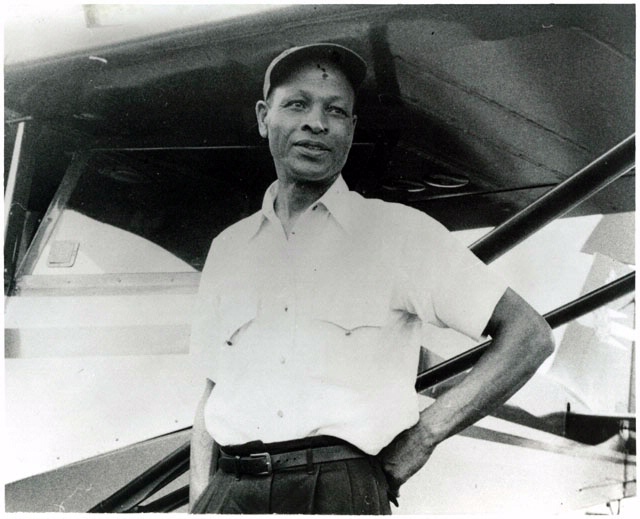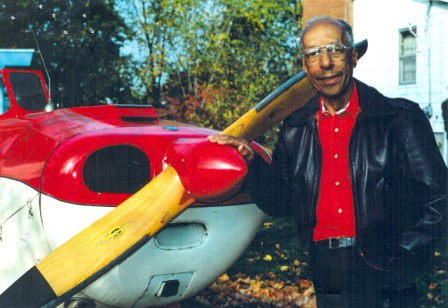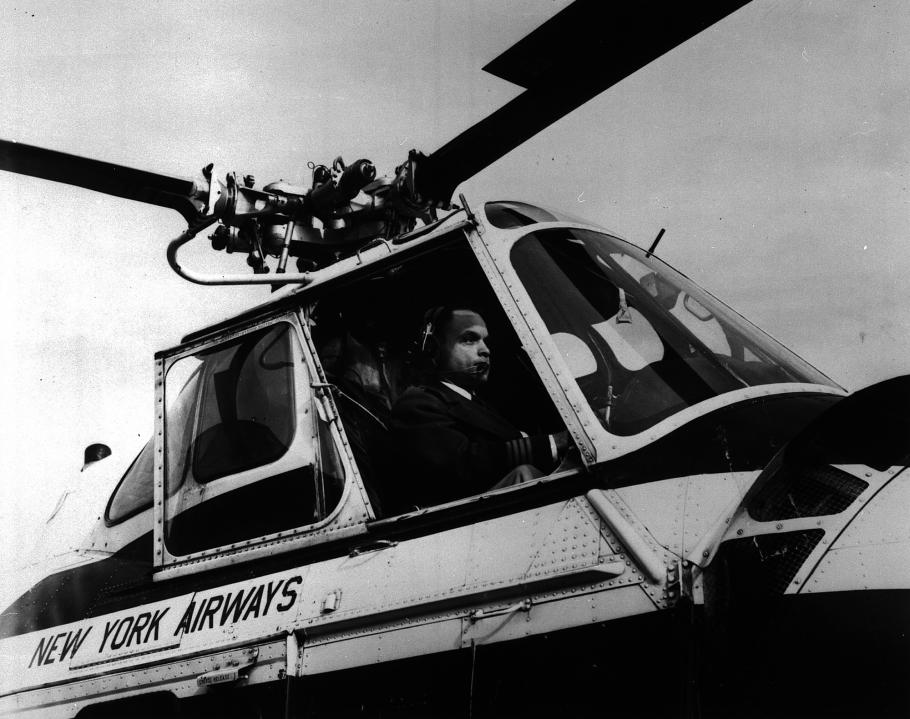
Eugene Jacques Bullard
Born on October 9, 1895, in Columbus, Georgia, Caporal Eugene Jacques Bullard was the first Black American military pilot who flew for France during World War I. After multiple futile attempts to find a flight school in the United States that would admit a Black student, Bullard moved to France and enlisted on October 19, 1914. He was sent to the 3rd Marching Regiment of the Foreign Legion before joining the Aéronautique Militaire on October 2, 1916, becoming an air gunner after training in Cazaux, Gironde. Subsequently, he transferred to Châteauroux and Avord where he received his pilot’s license on May 5, 1917, becoming the first Black American military pilot. Bullard had 14 awards and honors bestowed upon him by the French government, including the Croix de guerre, Médaille militaire, Croix du combatant, and the Médaille de Verdun. Additionally, he was made a Chevalier of the Légion d’honneur by General Charles de Gaulle in 1959. Eugene Jacques Bullard died on October 12, 1961 and was buried in Queens, New York with full French military honors.

Bessie Coleman
Born on January 26, 1892 in Atlanta, Texas, Bessie Coleman was the first Black American and Native American to be a licensed pilot. After developing a keen interest in aviation, she sought a school that would admit her, but she was turned away due to her race, as well as her gender. She found a spot at the Ecole d’Aviation des Freres Caudon in France, the only school that would admit a woman. On June 15, 1921, her pilot’s license was issued by the Fédération Aéronautique Internationale. She became well-known for her aerobatic style and on September 3, 1922, she gave the first public flight display in the United States by a Black American woman at Glenn Curtiss Field, Garden City, New York. She died on April 30, 1926, after a wrench jammed the control gears of her Curtiss JN-4D Jenny. Bessie Coleman was unable to recover from the subsequent nosedive and when the plane became inverted, she fell out of her seat and was killed upon impact.

Willie "Suicide" Jones
Willie Jones was born in 1915 on a farm near Leland, Mississippi. A strong-willed boy, at the age of 13 he ran away and came upon an airfield where he saw his first plane, and instantly fell in love with wanting to fly. The pilot he watched was a man named Vernon Omlie, who took Jones on as his pupil. That same afternoon, Omlie took Jones up in his plane, and instructed him carefully on how to climb out of the plane and onto the canvas wings. He was a wingwalker. From that day in 1928, his career began in stunt flying. His name quickly became recognizable for the death-defying stunts he would perform and knew just about every big name pilot of the time. He earned his nickname from a jump in 1934, where his ripcord had become entangled in his boot laces. Unbeknownst to the crowd, he struggled to get his chute open, and with only seconds remaining, was finally able to free the parachute and land. No one saw him land, and his pilot thought he was dead. It wasn't until the next day when he rode into town to meet his pilot (whom he had to convince he was still alive) did people recognize him as the man who surely had fallen to his death. He traveled with just about every flying circus in the United States, during which time he broke a world's record. In 1939 he performed his signature Ôdelayed-opening parachute jumping' and set a new world record.

William J. Powell
William J. Powell was born on July 27, 1897 in Henderson, Kentucky. Drawn to military service, Powell entered officer training school during World War I and became a first lieutenant but was poisoned by mustard gas during combat on his last day of duty and was sent back to the United States. He returned to France for a reunion with other American World War I veterans in 1926 and took his first flight at Le Bourget in Paris. Once he came back from Paris, Powell located a school in Los Angeles that would admit him but charged him $1,000 ($17,182.32) for the tuition. After earning his license, he founded the Bessie Coleman Aero Club in 1929. He organized the first all-Black airshow in September 1931, which generated enough interest to warrant a second exhibition in December. Powell authored the well-known book, Black Wings in 1934, in addition to producing a film and publishing a newsletter for Black pilots. William J. Powell’s ultimate goal was to inspire the younger generation of Black Americans, ensuring that they would continue his mission of representation and visibility within aviation. William J. Powell died on April 12, 1942 in Reno, Nevada.

James Herman Banning
Born on November 5, 1900 in Canton, Oklahoma, James Herman Banning became the first Black American pilot to be licensed in the United States. Academically inclined, in 1919 he was accepted to and attended Iowa State College with the goal of becoming an engineer. In the spring of 1920, Stanley M. Doyle gave Banning his first flight in a Curtiss JN-4 Canuck. The following year, he left Iowa State College and opened up his own auto repair shop, however, his interest in flying continued and in the winter of 1924, he left with the goal of obtaining his pilot’s license. Unable to find a flight school in the United States that would admit him, he located a World War I veteran to give him private lessons, and he earned his license in 1926. In 1932, Banning and his mechanic, Thomas C. Allen, took to the skies for a cross-country flight. In their Alexander Eaglerock A-1 biplane, they completed the journey in 3 weeks, with 42 hours of actual airtime. A year later, Banning was killed in a crash at Camp Kearny, San Diego, on February 5, 1933. Because of his race, he was not allowed to fly a biplane at the air show exhibition and was forced to be the passenger. Naval pilot Albert Burghardt stalled the plane and could not recover from the subsequent tailspin. James Herman Banning was 32.

Cornelius Coffey
Cornelius Coffey
Born on September 6, 1903 in Newport, Arkansas, Cornelius R. Coffey created the first all-Black pilot school, the Coffey School of Aeronautics, which trained over 1,000 aviators. Although it catered to Black students, it was open to anyone wishing to fly, irrespective of race or gender. Shortly thereafter, in 1931, he and John Robinson co-founded the Challenger Air Pilot’s Association. The Coffey School of Aeronautics was initially based at Akers Airport, because it was the only airport that would allow Black pilots, so, in 1933 they began flying out of Robbins, Illinois. Due to construction issues, they eventually moved the school to the now-defunct Harlem Airport. However, it remained segregated, unlike the Robbins location. In 1942 he became a commissioned Captain in the Civil Air Patrol and he continued to instruct new students on behalf of the Civilian Pilot Training Program. After World War II, Coffey continued his lifelong teaching career at the Lewis School of Aeronautics and Dunbar Vocational High School. Cornelius Robinson Coffey died on March 2, 1994 in Chicago, Illinois.

Neal V. Loving
Neal V. Loving
Born on February 4, 1916 in Detroit, Michigan, Neal V. Loving was the first Black American and the first double amputee to hold a racing license. At the age of 10, he saw an Airco DH-4 de Havilland biplane delivering mail and was smitten with airplanes. On May 5, 1930, Loving paid $5 for his first ride in a plane, a Curtiss OX-5 Waco. A year later, his family went on welfare, but despite that, he entered Cass Technical High School in Detroit, focusing on aeronautics. Throughout the 1930s, Loving taught aircraft mechanics and became an instructor at the Wayne School of Aeronautics in Michigan. During World War II, he was eager to join the Civil Air Patrol, but due to his race there were no local all-Black units, he formed Squadron 639-5 and became executive officer. On July 30, 1944, Loving crashed his plane due to lack of sleep and was forced to have his legs amputated. But only two years later, he had his pilot’s license reinstated and returned to teaching at his school. He became adept at modifying planes with his midget-class racer being his favorite, which he called Loving’s Love and entered it in the National Air Races in 1951. A few years later, he left his teaching position and went back to school, earning a degree in aeronautical engineering. Loving became an engineer at Wright-Patterson Air Force Base and spent the rest of his life designing and engineering experimental aircraft. Neal V. Loving died on December 19, 1998 in Yellow Springs, Ohio.

Perry Young Jr.
Perry Young Jr.
Born on March 12, 1919 in Orangeburg, South Carolina, Perry Young Jr. was the first Black American commercial pilot. Like many Black aviators of his generation, Young attended the Coffey School of Aeronautics. He earned his license with only three hours and 20 minutes of flying time. Due to his prodigious knowledge of flying, he became an instructor for Cornelius Coffey. After the United States entered World War II, Young was asked to join the 99th Pursuit Squadron and train new pilots, who later became known as Tuskegee Airmen. Young taught over 150 pilots, however he never flew in combat because of his status as an instructor. Despite his extensive experience, he was unable to get a job with an American airline company after the war, and ultimately, he sought employment in Haiti and Puerto Rico. In 1954, Young began training to be a helicopter pilot and was able to secure international routes, but none were consistent. He caught the eye of New York Airways, who were keen on promoting integration. And on February 5, 1957 Young started as a copilot on their Sikorsky S-58 Choctaw helicopters. He flew with New York Airways until 1979 and continued flying helicopters for various companies throughout the remainder of his career. Perry Young Jr. died November 8, 1998 in Middletown, New York.
2001 Pan American Plaza, San Diego, CA
Phone: 619.234.8291
Información En Español
Contact Us
We would like to thank all our sponsors who help us make a difference. Click here to view all who help us.

The San Diego Air & Space Museum is a 501(c)(3) non-profit organization. Federal Tax ID Number 95-2253027.